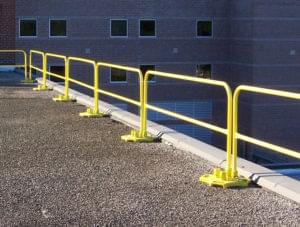Leading Edges: a regulatory term for a very real risk that every construction manager, laborer, or facilities maintenance worker understands too well. As a reminder, a leading edge is an unprotected edge and side of a floor, roof, or other walking/working surfaces which changes location as additional floor, roof, or formwork sections are placed. While a part of every job site (and theoretically, every building, period), they present a risk for even the most seasoned workers.
In this article, we’re exploring the different types of leading edges your team might encounter, along with other considerations, and how safety guard rails can protect them.
OSHA's technical regulatory terms are written to clearly define safety policies and procedures — you can find the list of terms here. For the purpose of this article, we are focusing on fall protection systems, include both passive fall prevention and active fall prevention systems. Passive fall prevention is used to prevent a fall from occurring, and includes guard railings, safety gates, covers, and safety nets. Active fall prevention halts a fall once it has begun, and includes personal fall arrest systems like safety harnesses and lanyards.
The OSHA height requirements for fall protection can be confusing. For general industry employees, any height above four feet needs to be protected, while in construction it’s six feet. Furthermore, on scaffolding it’s not required until ten feet.
Regardless of height, a fall can happen. And while a four-foot drop may not seem like much, no one wants to risk personal injury and time off from work. Adding a safety system to your leading edges (no matter how low to the ground), lets your workers focus on work, rather than falling.
There’s usually a lot happening on a construction site. Leading edges are in constant flux, and on any given day, you can have several projects underway at once, with various contractors and workers coming and going. There’s also permit inspections, inclement weather, and deadlines to contend with.
Additionally, fall protection systems for roofs need to take in additional considerations to keep their leading edges protected: pitch and size. Off the rooftop, workers need to be mindful of exposed work areas like scaffolding, elevator shafts, open window casements and skylights, and so on.
Like construction sites, factories, warehouses, and assembly lines are busy places. Quotas need to be met and production needs to be top of mind. With all that coming and going, it’s easy to overlook the fall risks associated with leading edges found on elevated walkways, loading docks, and mezzanines. There’s also likely a large HVAC system that needs regular maintenance to ensure efficiency of both your machinery and your employees. These systems are frequently located on the roof, which can be precarious places to work — especially when there is bad weather. Regardless of industry, fall protection systems for roofs are a must if anyone needs to be out there.
Outside of leading edges, many industries have a host of other dangers — many of them at floor height. Dangerous obstacles like machines, tanks, and vats are exceptions to the height rule. Falls, physical injury, and chemical exposure are all a possibility and prevention goes a long way when it comes to protecting against these hazards. Smart use of safety guard rails around this kind of equipment can not only prevent bodily injury, but headaches and lawsuits down the road.
After you determine whether your leading edge needs a safety system (and it likely does), the next step is to determine the best type. As mentioned above, passive systems focus on securing the site, while active systems secure your individual workers.
Personal fall arrest systems fall under the “active” category. These include harnesses, lanyards, and lifelines and they focus on the single person who is performing the job at hand. For the type of work where a passive system is prohibitive or insufficient, these systems allow for maneuverability and give added security.
 Guard railings are passive safety systems that keep people from falling over a leading edge — or any other area you’re looking to protect. They are a smart choice regardless of your facility and take a lot of guesswork out of protection. In fact, many companies choose to use guardrails in tandem with other safety devices for added security, especially along leading edges, loading docks, elevated walkways, and around equipment.
Guard railings are passive safety systems that keep people from falling over a leading edge — or any other area you’re looking to protect. They are a smart choice regardless of your facility and take a lot of guesswork out of protection. In fact, many companies choose to use guardrails in tandem with other safety devices for added security, especially along leading edges, loading docks, elevated walkways, and around equipment.
At some point, most businesses will discover a need for fall protection. Since guard railings can be both penetrating or non-penetrating, companies can choose to make them permanent fixtures or temporary solutions. With non-penetrating guard railings, an added benefit is minimized damage to the rooftop or other surface. So no matter what type of leading edge you’re faced with, safety guard rails are one of the smartest types of fall protection systems for roofs available.
Being extra adamant about your company’s fall protection practices, whether around leading edges or other fall hazards, will not only protect your employees, but also guard you from OSHA fines and save you money in the long run.